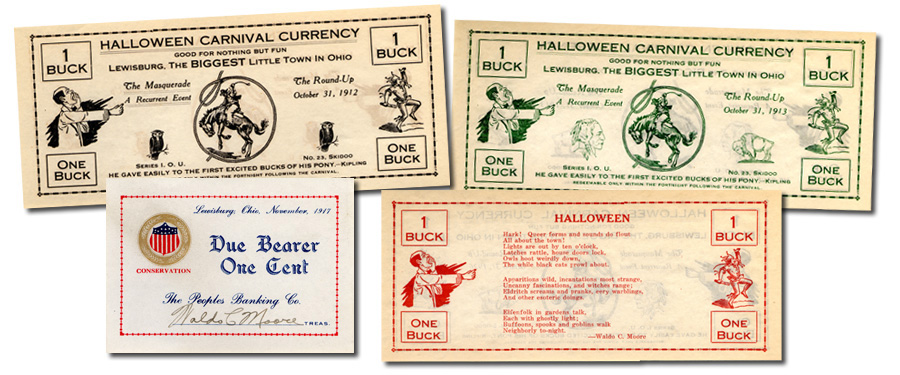
Trick or Treat and Happy Hallowe’en to all our readers from Waldo C. Moore, president of the American Numismatic Association, 1919-1921, and from Lewisburg, the “Biggest Little Town in Ohio.” Moore (1874-1953) was born in West Baltimore, Ohio (now Verona) and attended the Dayton Normal School and the Miami Commercial College in Dayton. He was an exceptional student in his younger days and ranked second in his county for academic achievement. In 1910, Moore took a series of examinations and earned his bookkeeping degree, becoming very successful in his chosen field. After his marriage he and his wife farmed a 200-acre spread, a stock farm in Preble, Ohio. He also worked as a Banker for The People’s Banking Company, serving as Treasurer for years.
Most significant about Moore were his collecting habits. He was an accomplished numismatist and philatelist, and was also in the forefront of check collecting. Indeed, at the time, his collections in the above disciplines were considered among the finest. Moore was also a student of Ohio banking regulations and history and was appointed as a trustee of the Ohio Archeological and Historical Society by Ohio’s Governor Willis in 1915. In 1919, Moore was elected president of the ANA for a three-year term. During his many years of membership, Moore wrote over 130 articles and poems for The Numismatist.
Moore’s check collection was unique. He frequently sent one-cent chits from the People’s Banking Co. to famous celebrities and other important people in exchange for a one-cent check from the celebrity, to which a surprising amount of famous people responded. Even Annie Oakley responded with a check for one-cent, informing Moore she kept his one-cent chit in her scrapbook! Meanwhile, for many years in Lewisburg, Ohio that small town held a Hallowe’en Carnival and issued “bucks” worth one dollar face value in town “redeemable only within the fortnight following the carnival.” In my collection I have notes of 1912, 1913, 1919, 1923, 1924, 1926, 1928, 1931, and 1933. The face of the 1912 issue features a wise old owl above “Series I.O.U.” In 1913, the first year of Buffalo nickel coinage, Moore replaced the owl with the obverse and reverse of James Earle Fraser’s iconic Buffalo nickel. The back of each note is identical except in 1912 which featured the owls; all the others have the Buffalo nickel design except in 1926, when Moore’s poem, Halloween, makes up the back design. Front-back color combinations include 1912, black/gold, buff paper; 1913, black/green, buff paper; 1919, black/gold, buff paper; 1923, black/green, buff paper; 1924, black/gold, buff paper; 1926, black/red, buff paper; 1928, red/black, buff paper with olive background; 1931, black/blue, green paper with buff background; and 1933, red/ black, green paper with buff background. These Hallowe’en notes have brought me much enjoyment over the years, and this week seemed so appropriate to write about them in The Exonumia Corner.





